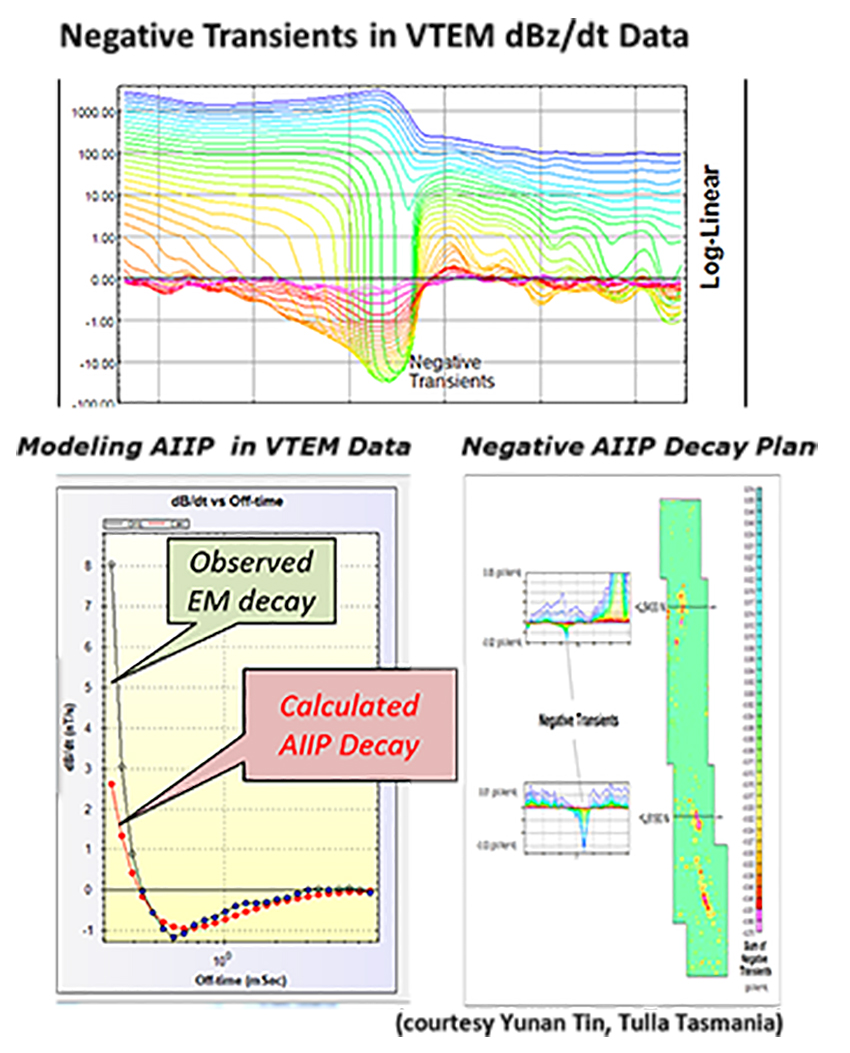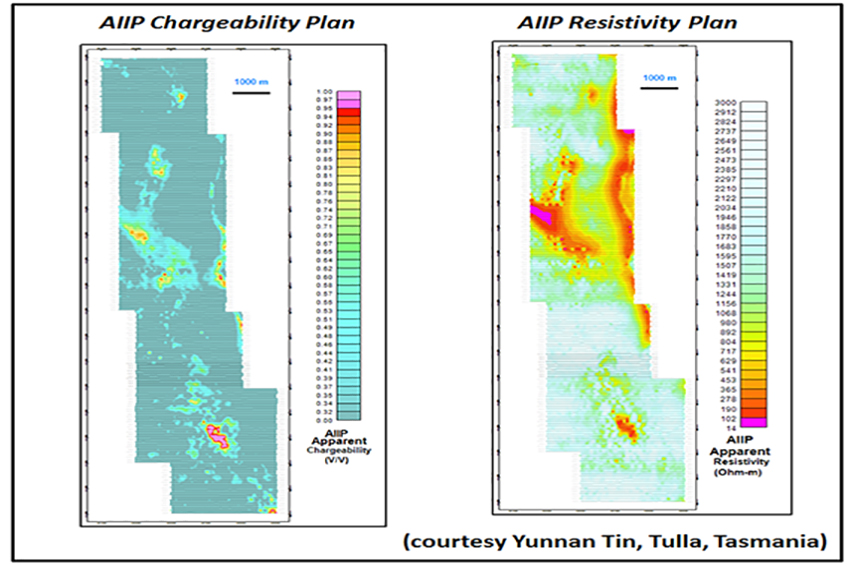Recently as an industry leader, Geotech has spearheaded efforts to extract induced polarization effects from its VTEM data – notably in the work of Karl Kwan and Alexander Prikhodko who have modelled AIIP effects in VTEM using the well-known Cole-Cole relaxation model, which they’ve adapted to the Airbeo 1D EM layered-earth modeling code by AMIRA/CSIRO – making it a fast, low cost alternative to the 3D inversion method used by other workers.
First we should ask the following questions: What is AIIP and how are these effects seen in airborne TDEM ? In any time-domain EM measurement, like VTEM, there are at least two types of physical phenomena that are mainly measured: 1) Electromagnetic (EM) induction, which we use to map Conductivity, and 2) Induced polarization (IP), which gives us Chargeability. The EM induction effect causes a positive EM decay, whereas the AIIP effect causes a negative EM decay. Both the EM and IP effects are combined in a typical airborne EM measurement, but most times the AIIP effect is so small that it is not visible above the EM effect. However, when rocks are sufficiently resistive, which makes the EM effect small, the AIIP effect is readily observed as a negative transient (Fig. 1) – but only if the airborne EM data is of the highest quality and EM decays can be followed into the latest time-channels. Hence, VTEM data by their nature are highly suited for mapping AIIP.
One of the first examples of extracting the chargeability from VTEM data was taken from Mt Milligan, BC where the AIIP chargeability map obtained by Kwan et al. (2015a) closely resembled the results obtained by Kang et al. (2014) using the more expensive and time-consuming 3D EM inversion code. Interestingly, AIIP data can even be extracted from VTEM data even when negative transients are not observed. This was documented in the Kwan et al. (2015b) paper at Cerro Quema, Panama. In some cases, AIIP effects can be stronger than the EM bedrock response, which can distort the EM resistivity sounding unless they are accounted for. This was documented in the Kwan et al (2015c) paper on permafrost effects in VTEM data from Mirny, Russia.
Highlights of AIIP
- High quality data has always been one of the strongpoints of the VTEM systems, meaning that AIIP effects can be mapped regardless of the type and age of VTEM data. AIIP chargeability processing is now routinely performed as a final survey deliverable for all 2015 VTEM surveys (Fig. 2) but AIIP has also been extracted from VTEM data sets dating back to 2007.
- Chargeability is an independent geophysical property, separate from conductivity and magnetic susceptibility. VTEM survey data allows for the simultaneous measurement of all three physical properties which allows us to better characterize the rocks that are hidden at depth.
- Geotech’s AIIP processing is relatively quick and inexpensive, easily completed in a few days and costing a few dollars per kilometre, thus making it worthwhile revisiting a previous survey data set to extract potentially new information about your property’s geology.
If you have VTEM data that you would like to discuss further regarding the potential of AIIP please contact Geoffrey Plastow, Data Processing Manager at Geoffrey.plastow@geotech.ca.
Selected References on AIIP
Kwan, K., Prikhodko, A., Legault, J.M., Plastow, G., Xie, J., and Fisk, K., 2015, Airborne inductive induced polarization chargeability mapping of VTEM data: ASEG-PESA, Extended abstracts, 4 p. For case study click here.
Kwan, Prikhodko, A., Legault, J.M., Plastow, G., Kapetas, J., and Druecker, M., 2015: VTEM airborne EM, aeromagnetic and gamma-ray spectrometric data over the Cerro Quema high sulphidation epithermal gold deposits, Panama: ASEG-PESA, Extended abstracts, 4 p. For case study click here.
Kwan, K., Prikhodko, A., Legault, J.M., and Goncharov, E., 2015, Airborne inductively induced polarization effects in and their removal from VTEM data from Mirny, Russia: SEG, Expanded abstracts, 5 p. For the case study click here.
Other References on Airborne IP
Kratzer, T., and Macnae, J.C., 2012, Induced polarization in airborne EM: Geophysics, 77, E317-E327.
Marchant, D., Haber, E., and Oldenburg, D.W., 2014, Three-dimensional modeling of IP effects in time-domain electromagnetic data: Geophysics, 79, E303-E314.
Smith, R.S., and Klein, J., 1996, A special circumstance of airborne induced polarization measurements: Geophysics, 61, 66-73.

